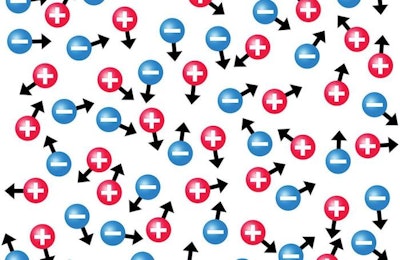
The balance of dietary cations (positively-charged ions) and anions (negatively-charged ions) is in close relationship with broiler performance affecting metabolism quite differently than individual ions. Dietary electrolyte balance (dEB), also known as cation-anion difference (CAD), is calculated using only the monovalent ions of sodium, potassium and chlorine. A more comprehensive estimate, however, takes into account the contribution of divalent ions of calcium, magnesium, sulfur and phosphorus, but it is used less frequently because it requires more chemical analyses. For all practical purposes, the following equation is sufficient under most commercial conditions:
dEB (mEq/kg) = 1,000 ´[Na(g/kg)/23 + K(g/kg)/39 – Cl(g/kg)/35.5]
Why dEB is significant
Dietary electrolyte balance is an indication of the metabolizable ions that can generate or consume acid during metabolism. As such, the very significant balance between acids and bases in the organism is closely related to the cation-anion balance. Diets with a low dEB are likely to cause metabolic acidosis, whereas alkalosis is expected with diets high in dEB. Metabolic acidosis has been implicated with reduced feed intake — the most obvious symptom that affects productivity. Dietary electrolyte balance may also affect energy, amino acid, vitamin and mineral metabolism. For example, excess dietary alkalinity (high dEB) may increase lysine oxidation and, thus, increase the requirement for lysine.
Summer and dEB in broilers
Heat stress causes excess panting leading to respiratory alkalosis. As the birds pant, they respire excessive amounts of carbon dioxide, which leads to reduced concentrations of carbonic acid and hydrogen. In response, the kidneys respond by regulating excretion and secretion of these compounds in an attempt to maintain the acid-base balance. As a consequence, the balance of monovalent ions — closely related to acid-base balance — also change: Potassium and sodium concentrations decrease, whereas that of chlorine increase. In reverse, it is hypothesized that by altering the dietary electrolyte balance during heat stress, it might be possible to minimize the negative effects of heat stress. To this end, several salts are added to broiler feeds and water.
Salts that alter dEB
The most common salts used to adjust dEB in broiler diets include the following:
- Sodium carbonate
- Potassium chloride
- Sodium chloride
- Ammonium chloride
- Potassium sulphate
The two most common salts are sodium bicarbonate and potassium chloride. Other minerals implicated in alleviating the symptoms of heat stress are zinc and magnesium, but there is less evidence for them, at the moment.
Dietary electrolyte balance is an index that must be monitored in all feeds throughout the year.
The usual method of administering these salts is through the feed, but water supplementation is also an interesting alternative. The latter does not involve reformulation and delivery of a special diet, and as such it can be used during short spells of excessive heat.
Here it merits noting that not all of the above salts are suitable for layers. In laying hens, the use of inappropriate salts may result in reduced eggshell quality, and a different blend of salts is required. In contrast, other additives, such as sodium zeolite have been tested with success in layers. This additive (a common anti-mycotoxin agent) has been shown to reduce the effects of heat stress in layers without affecting eggshell quality.
Heat stress beyond dEB
Dietary electrolyte balance is an index that must be monitored in all feeds throughout the year. Lamentably, it only becomes of interest only when nutritionists attempt to add salts such as those described above to combat heat stress. To this end, it should be emphasized that adding salts alone seldom offers birds the full possible protection from heat stress. Apart from facility and feed management changes required, feed reformulation is a more complicated issue. Other additives are required to complete the positive effects of salts, which many believe are due to increased water intake. Such additives include betaine, vitamin C and vitamin E. The latter possibly due to increased oxidative stress associated with heat stress. As such, broiler feeds can be supplemented with a special summer "booster" package that includes several ingredients and not just salts.
Targets for dEB
It is widely accepted that dEB below 0 mEq/kg is associated with severely depressed performance, whereas values between 0 and 300 mEq/kg are considered more appropriate, albeit research results have been variable. Most commercial broiler feeds contain about 200 mEq/kg, whereas a more appropriate value should be closer to 250 mEq/kg. Nevertheless, these numbers are based as much on practical experiences as on research, and until more definitive answers become available, they should suffice.

















